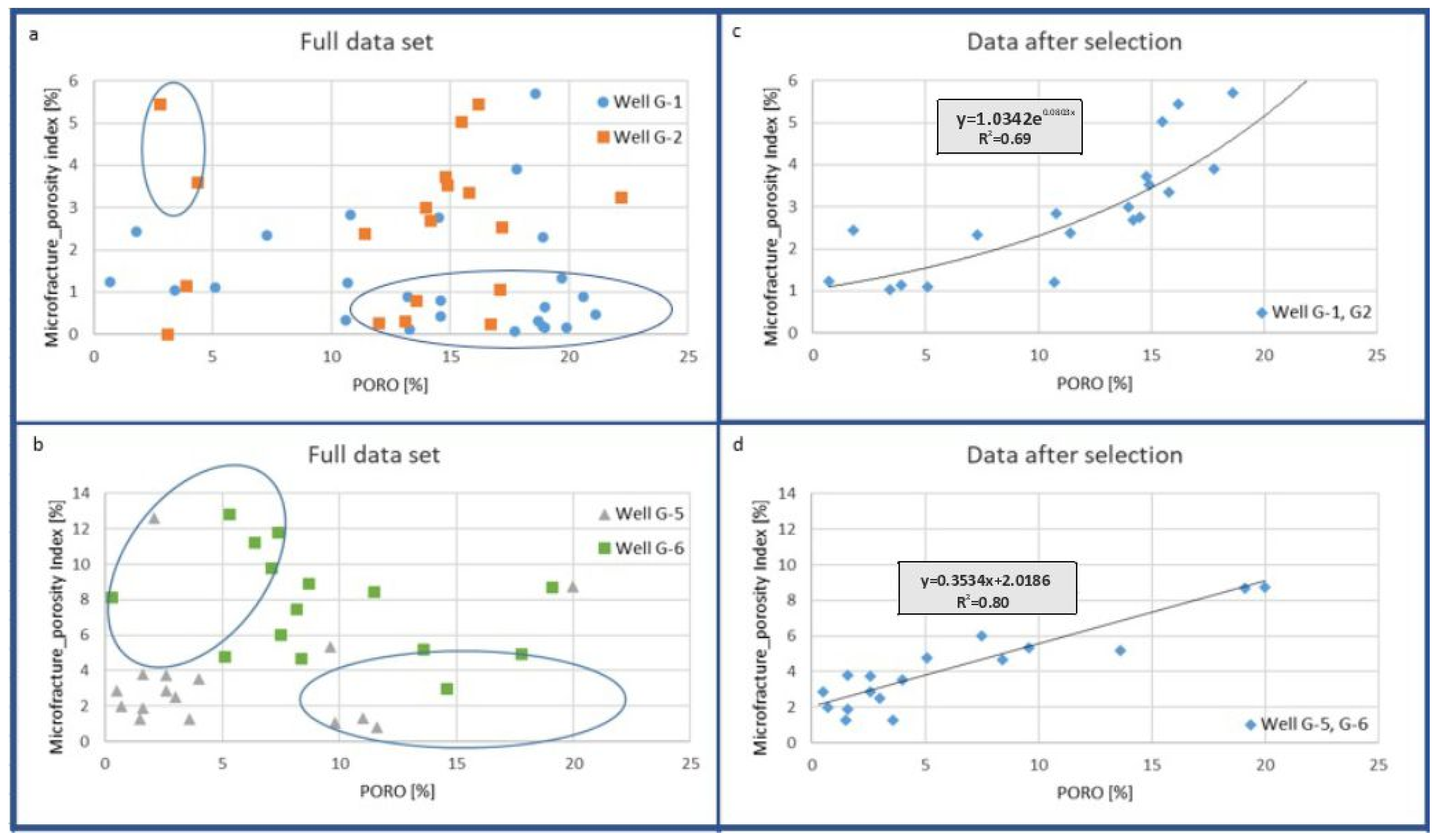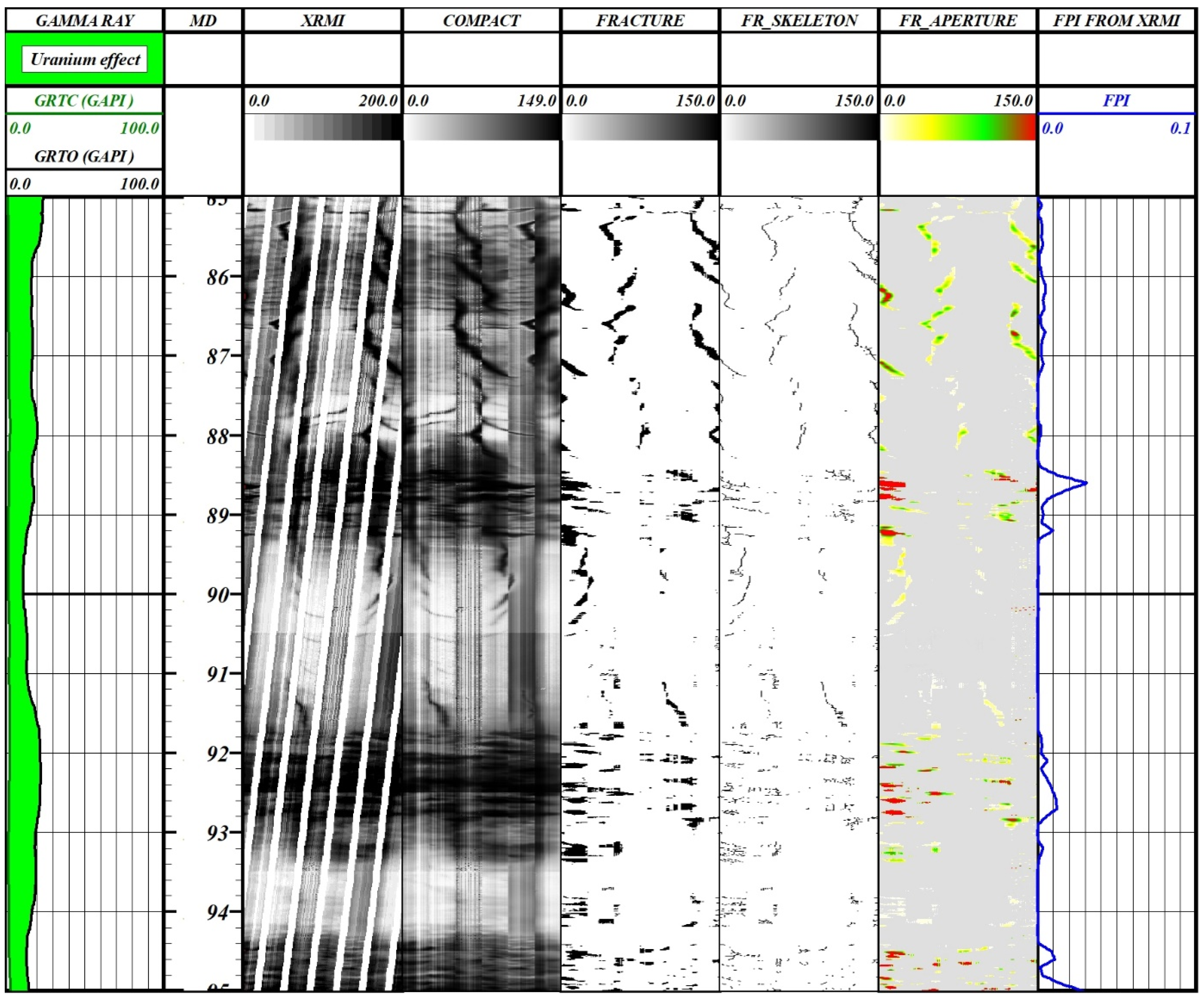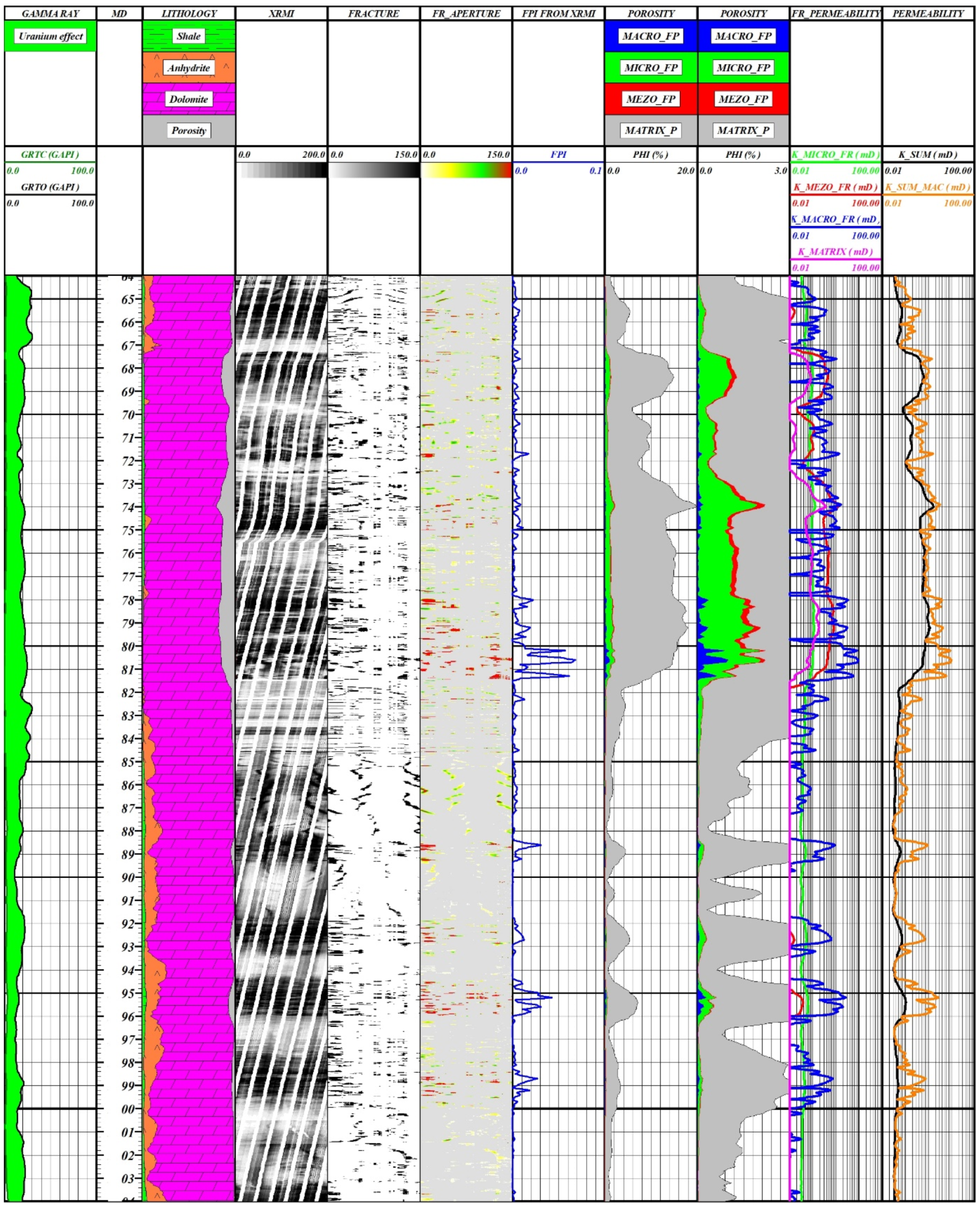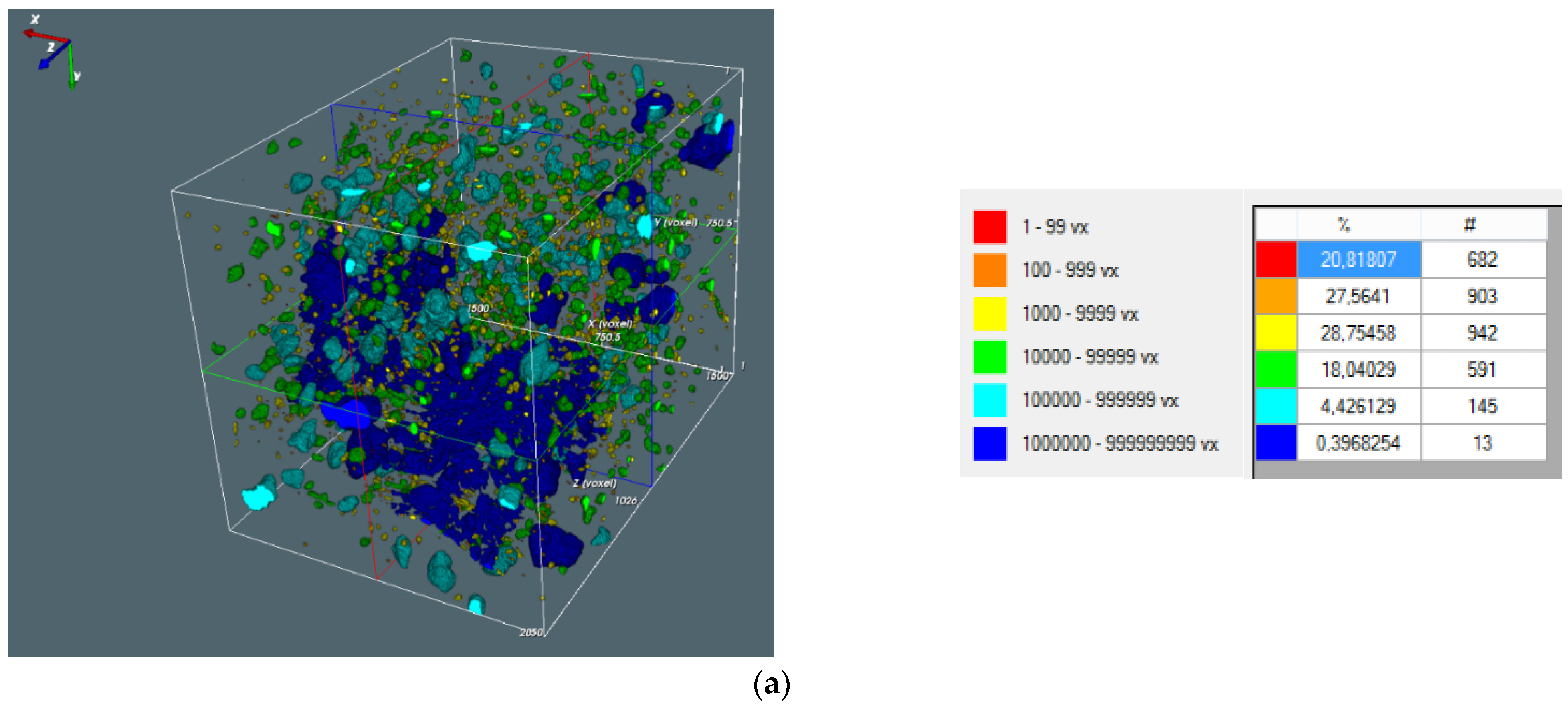Characterization of the Carbonate Formation Fracture System Based on Well Logging Data and Results of Laboratory Measurements
Abstract
:1. Introduction
2. Geological Settings
3. Methods
- Determining fracture density. A measurement is based on planimetry analysis of a whole sample (number of vision fields must be at least 250) and counting of crossings of microfractures with a chosen arm of cross in the eyepiece (for every vision field separately). A proper magnification level was chosen based on the size of the microfractures. The optimum was around 100–150×. During planimetry analysis, microfractures of a width less than 0.1 mm should not be taken under consideration because they are analyzed during measurements on replicas.
- Measurement of microscope’s vision field. To perform calculations, we also needed to measure the microscope’s vision field under the magnification we adopted. In order to do so, a thin section with a millimeter standard was used.
- Measurement of microfracture thickness. In order to estimate a microfracture’s thickness, about 100 measurements need to be performed to obtain the average value of the results. It is essential to know that measuring the thickness of a few large microfractures can result in a great increase in the average thickness. To estimate the microfracture’s thickness, a weighted mean was used.
- Performing calculations.
4. Materials—Data Sources and Analyses
4.1. Relations between Petrophysical Parameters from the Whole Data Set
4.2. Laboratory Petrophysical Parameters (MICP) vs. Well Logging Results in G-5 Borehole Data Set
5. Results
5.1. Analysis of Data Set
- PORO > ~10% and Microfracture porosity Index < ~1%;
- PORO < ~5% and Microfracture porosity Index > ~3%;
- The rest of the data.
5.2. Fracture Permeability Analysis
5.2.1. Micro- and Mezzofracture Permeability Analysis
5.2.2. Matrix Permeability Analysis
5.3. Fracture System Evaluation from Well Logs
5.3.1. Macrofracture Analysis from Electric Imager
- -
- Canceling of the breaks between pad registration to obtain homogeneous vector data and vector curves COMPACT;
- -
- Fracture tracing using the filtration and skeletonization procedures to obtain vector curves FRACTURE and FR_SKELETON;
- -
- Calculating the aperture of recognized fractures to obtain vector curves FR_APERTURE.
5.3.2. Fracture Porosity and Permeability Calculation (Well G-10)
- Microfracture porosity calculation according to Equations (7) and (8) (Figure 7d)MICRO_FP = (Microfracture porosity Index/100) ∗ PHI
- Mezzofracture porosity calculation according to Equations (9) and (10) (Figure 8d)MEZZO_FP = (Mezzofracture porosity Index/100) ∗ PHI [%]
- Macrofracture porosity calculation according to Equation (11)
- Matrix porosity calculation according to Equation (12)MATRIX_P = PHI − (MICRO_FP + MEZO_FP + MACRO_FP [%]
- Microfracture permeability calculation according to Equation (13)K_MICRO_FR = 1.385 ∗ MICRO_FP [mD]
- Mezzofracture permeability calculation according to Equation (14) (Figure 9)K_MEZO_FP = 119.22 ∗ MEZO_FP1.7756 [mD]
- Matrix permeability calculation according to Equation (15) (Figure 10)LOG (K_MATRIX) = 0.0854 ∗ PHI − 2.2373
- Rock permeability without macrofractures calculation according to Equation (16)K_SUM = K_MICRO_FR + K_MEZO_FR + K_MATRIX [mD]
- Macrofracture permeability calculation according to Equation (17)K_MACRO_FR = MACRO_FP ∗ K_MACRO [mD]
- Total permeability calculation according to Equation (18)K_SUM_MAC = K_SUM + K_MACRO_FR [mD]
5.4. Discussion of the Results
6. Microtomography Exploration of Limestone Lithology Sample
7. Conclusions
Author Contributions
Funding
Institutional Review Board Statement
Informed Consent Statement
Data Availability Statement
Acknowledgments
Conflicts of Interest
References
- Perrodon, A. Dynamics of Oil and Gas Accumulations; Elf Aquitaine: Pau, France, 1983; ISBN 2-901026-12-5. [Google Scholar]
- Semyrka, R. Quantitative and qualitative petrophysical characteristics of main dolomite subfacies in pleogeographical zones. Miner. Resour. Manag. 2013, 29, 99–114, (In Polish, Abstract in English). [Google Scholar] [CrossRef] [Green Version]
- Mikołajewski, Z. Petrological Characteristics of the Main Dolomite in the Region Gorzów-Pniewy. In Report on the Scientific Project No NN 525 348538; AGH University of Science and Technology: Krakow, Poland, 2011. (In Polish) [Google Scholar]
- Semyrka, R.; Semyrka, G.; Zych, I. Variability of petrophysical parameters of subfacies in the Main Dolomite strata of the western Grotów Peninsula area in the light of porosimetric measurements. Geologia 2008, 34, 445–468, (In Polish, Abstract in English). [Google Scholar]
- Aguilera, R. Naturally Fractured Reservoirs; Penn Well Publ. Comp.: Tulsa, OK, USA, 1980; pp. 1–703. [Google Scholar]
- Rzyczniak, M.; Solecki, M.L.; Zeljaś, D.; Dubiel, S.J. The effect of pressure depression on the water inflow volume to wells which cover carbonate rocks in the Carpathian Foredeep basement, SE Poland. Rudarsko-geološko-naftni zbornik 2021, 36, 34–42. [Google Scholar] [CrossRef]
- Arns, C.H.; Bauget, F.; Ghous, A.; Sakellarion, A.; Senden, T.J.; Sheppard, A.P.; Sok, R.M.; Pinczewski, W.V.; Kelly, J.C.; Knackstedt, M.A. Digital Core Laboratory: Petrophysical Analysis from 3D Imaging of Reservoir Core Fragments. Petrophysics 2005, 46, 260–277. [Google Scholar]
- Fadhil, D.T.; Yonus, W.A.; Theyab, M.A. Reservoir characteristics of the Miocene age formation at the Allas Dome, Hamrin Anticline, Northern Iraq. MMD J. 2020, 14, 17–23. [Google Scholar]
- Jaworowski, K.; Mikołajewski, Z. Oil-and gas-bearing sediments of the Main Dolomite (Ca2) in the Międzychód region: A depositional model and the problem of the boundary between the second and third depositional sequences in the Polish Zechstein Basin. Prz. Geol. 2007, 55, 1017–1024. [Google Scholar]
- Paduszynski, J. Szacowanie gęstości mikroszczelin metodą trawersów losowych. Nafta 1965, 1, 2–3. (In Polish) [Google Scholar]
- Karpyn, Z.; Alakmi, A.; Parada, C.; Grader, A.S.; Halleck, P.M.; Karacan, O. Mapping Fracture Apertures Using Micro Computed Tomography. In Proceedings of the International Symposium of the Society of the Core Analysts, Pau, France, 21–24 September 2003; SCA 2003–50. Available online: https://www.ux.uis.no/~s-skj/ipt/Proceedings/SCA.1987-2004/1-SCA2003-50.pdf (accessed on 30 August 2021).
- Krakowska, P.I. Innovative Method of Unconventional Oil and Gas Reservoirs Interpretation Using Computed X-ray Tomography; Project Report; National Centre for Research and Development: Warsaw, Poland, 2019; Unpublished. [Google Scholar]
- Semyrka, R.; Jarzyna, J.A.; Krakowska, P.; Semyrka, G. Statistical analysis of the main dolomite microfacies parameters in the boundary zone of carbonate platform. Miner. Resour. Manag. 2015, 31, 123–140. [Google Scholar]
- Wagner, R. Paleogeografia Dolomitu Głównego-Platforma Gorzowa i N część Platformy Wielkopolskiej. In Algowe Skały Macierzyste Dolomitu Głównego i ich Potencjał Węglowodorowy jako Podstawa dla Genetycznej Oceny Zasobów ropy Naftowej i gazu Ziemnego w Rejonie Gorzowa-Międzychodu. Cz. I, Charakterystyka Geologiczna; Wagner, R., Kotarba, M., Eds.; PGNiG S.A. (Archive): Warsaw, Poland, 2004. (In Polish) [Google Scholar]
- Jarzyna, J.A.; Semyrka, R.; Wawrzyniak-Guz, K.; Semyrka, G. Well Logging and Lab Data and Acoustic Instantaneous Attributes to Improve Facies Recognition of Reservoir Rock. In Proceedings of the 74th EAGE Conference and Exhibition Incorporating EUROPEC 2012, Copenhagen, Denmark, 4–7 June 2012. [Google Scholar] [CrossRef]
- Webb, P.A. An Introduction to the Physical Characterization of Materials by Mercury Intrusion Porosimetry with Emphasis on Reduction and Presentation of Experimental Data; Micrometrics Instruments Corp.: Norcross, GA, USA, 2011. [Google Scholar]
- Smechov, J.M. (Ed.) Trescinovatost Gornych Porod i Trescinnovye Kollektory; Trudy WNIGRI: Leningrad, Russia, 1962. [Google Scholar]
- Romm, E.S. Usowierszenstwowanie Metoda Szlifow dla Opriedielienia Paramietrow Triescinowatosci; Trudy WNIGRI: Leningrad, Russia, 1970. [Google Scholar]
- Kirby, J.T. Chapter 1 Boussinesq models and applications to nearshore wave propagation, surf zone processes and wave-induced currents. Elsevier Oceanogr. Ser. 2003, 67, 1–41. [Google Scholar]
- HESP: Halliburton Entreprise de Services aux Puits. X-tended Range Micro Imager (XRMI™) Tool. Available online: https://hesp.com/index.php/services/open-hole/imaging/xrmi-i-logiq-extended-range-micro-imager (accessed on 9 August 2021).
- Serra, O.; Abbott, H.T. The Contribution of Logging Data to Sedimentology and Stratigraphy. Soc. Pet. Eng. J. 1982, 22, 117–131. [Google Scholar] [CrossRef]
- Cnudde, V.; Boone, M. High-resolution X-ray computed tomography in geosciences: A review of the current technology and applications. Earth Sci. Rev. 2013, 123, 1–17. [Google Scholar] [CrossRef] [Green Version]
- Krakowska, P. Detailed parametrization of the pore space in tight clastic rocks from Poland based on laboratory measurement results. Acta Geoph. 2019, 67, 1765–1776. [Google Scholar] [CrossRef] [Green Version]
- PoROSE Help. Available online: www.porose.pl (accessed on 9 August 2021).
- Aguilera, R. Analysis of naturally fractured reservoirs from conventional well logs. JPT 1976, 6, 764–771. [Google Scholar] [CrossRef]
- Sowiżdżał, K.; Stadtműller, M. Methodology of 3D Fracture Reservoir Modeling. In Proceedings of the GEOPETROL 2010 Conference Proceedings, Zakopane, Poland, 29 September 2010; pp. 105–111, (In Polish, Summary in English). [Google Scholar]
- Stadtműller, M. Well logging interpretation methodology for carbonate formation fracture system properties determinantion. Acta Geoph. 2019, 67, 1933–1943. [Google Scholar] [CrossRef] [Green Version]
- Luthi, S.M.; Souhaite, P. Fracture apertures from electrical bore-hole scans. Geophysics 1990, 55, 821–833. [Google Scholar] [CrossRef]
- Stadtműller, M.; Kowalik, J. Possibilities of Fracture Aperture Evaluation Based on Well Logs-Methodical Aspects. In Proceedings of the GEOPETROL 2012 Conference Proceedings, Zakopane, Poland, 29 September 2012; pp. 355–358, (In Polish, Summary in English). [Google Scholar]
- Domenico, S.N. Rock lithology and porosity determination from shear and compressional wave velocity. Geophysics 1984, 49, 1188–1195. [Google Scholar] [CrossRef]















| Parameter/ Statistics | MD | TP | SD_MICP | D_MICP | P_MICP | DAC_MICP | LOG10 (DAC) | SA_MICP | Hysteresis |
|---|---|---|---|---|---|---|---|---|---|
| (g/cm3) | (%) | (g/cm3) | (g/cm3) | (%) | (μm) | (m2/g) | (%) | ||
| All plugs (136) | |||||||||
| MIN | 2.66 | 0.00 | 2.46 | 1.87 | 0.00 | 0.00 | −1.56 | 0.00 | 6.00 |
| AVER | 2.86 | 11.00 | 2.81 | 2.52 | 10.42 | 1.16 | −0.48 | 0.55 | 54.34 |
| MED | 2.86 | 10.5 | 2.82 | 2.50 | 10.18 | 0.30 | −0.53 | 0.51 | 5.00 |
| MAX | 2.99 | 33.19 | 3.04 | 2.88 | 24.05 | 49.00 | 1.69 | 1.44 | 85.00 |
| Parameter/ Statistic | DT | GR | RHOB | PHI | VDOL | VANH | VCL |
|---|---|---|---|---|---|---|---|
| (μs/ft) | (API) | (g/cm3) | (dec) | (dec) | (dec) | (dec) | |
| MIN | 45 | 8 | 2.53 | 0.3 | 0 | 0 | 0 |
| AVER | 52 | 31 | 2.79 | 4.81 | 0.55 | 0.35 | 0.03 |
| MED | 50 | 28 | 2.81 | 3 | 0.55 | 0.38 | 0.02 |
| MAX | 69 | 81 | 2.96 | 20 | 0.97 | 0.95 | 0.13 |
| Microfractures | Mezzofractures | ||||||||
|---|---|---|---|---|---|---|---|---|---|
| Well | Fracture Porosity | Fracture Permeability | PORO | PERM | Well | Fracture Porosity | Fracture | PORO | PERM |
| Permeability | |||||||||
| (%) | (mD) | (%) | (mD) | (%) | (mD) | (%) | (mD) | ||
| G-1 | 2.832 | 4.843 | 10.80 | 0.132 | G-1 | 0.217 | 1.04 | 10.80 | 0.132 |
| 1.037 | 1.437 | 3.40 | 0.864 | 0.100 | 0.20 | 14.60 | 0.087 | ||
| 2.335 | 3.234 | 7.30 | 0.010 | 0.048 | 0.11 | 20.60 | 4.471 | ||
| 0.802 | 1.111 | 14.60 | 0.087 | 0.113 | 0.21 | 19.00 | 2.880 | ||
| 0.332 | 0.460 | 10.60 | 0.036 | 0.308 | 2.51 | 19.00 | 1.191 | ||
| 0.879 | 1.217 | 13.20 | 0.001 | 0.999 | 13.20 | 18.60 | 0.319 | ||
| 0.155 | 0.215 | 19.90 | 0.169 | 0.271 | 1.34 | 17.80 | 0.095 | ||
| 0.114 | 0.158 | 13.30 | 0.353 | 0.202 | 1.18 | 10.70 | 0.045 | ||
| 0.427 | 0.591 | 14.60 | 0.081 | 0.076 | 2.97 | 5.10 | 0.012 | ||
| 0.074 | 0.102 | 17.70 | 2.049 | 0.759 | 30.07 | 0.70 | 0.001 | ||
| 0.320 | 0.443 | 18.70 | 1.224 | 0.156 | 1.69 | 1.80 | 0.001 | ||
| 1.321 | 1.830 | 19.70 | 2.805 | G-2 | 0.26 | 29.16 | 2.80 | 0.001 | |
| 0.883 | 1.223 | 20.60 | 4.471 | 0.14 | 3.40 | 3.90 | 0.001 | ||
| 0.634 | 0.878 | 19.00 | 2.880 | 0.42 | 28.00 | 4.40 | 0.001 | ||
| 0.167 | 0.232 | 19.00 | 1.191 | 0.06 | 0.90 | 13.10 | 0.001 | ||
| 0.174 | 0.241 | 18.90 | 2.806 | 0.09 | 8.80 | 15.80 | 0.015 | ||
| 0.472 | 0.654 | 21.10 | 5.808 | 0.28 | 24.00 | 15.50 | 0.056 | ||
| 5.706 | 7.904 | 18.60 | 0.319 | 0.21 | 29.70 | 22.20 | 0.002 | ||
| 2.752 | 3.812 | 14.50 | 0.025 | 0.22 | 5.60 | 14.90 | 0.075 | ||
| 3.899 | 5.401 | 17.80 | 0.095 | 0.07 | 2.90 | 14.20 | 0.698 | ||
| 1.216 | 1.685 | 10.70 | 0.045 | G-5 | 0.27 | 20.60 | 2.10 | 0.001 | |
| 2.300 | 3.185 | 18.90 | 0.283 | 0.21 | 4.50 | 9.60 | 0.001 | ||
| 1.099 | 1.522 | 5.10 | 0.012 | 0.13 | 3.00 | 20.00 | 1.283 | ||
| 1.236 | 1.711 | 0.70 | 0.001 | 0.17 | 23.20 | 2.60 | 0.001 | ||
| 2.441 | 3.381 | 1.80 | 0.001 | 0.08 | 3.10 | 3.00 | 0.001 | ||
| G-2 | 5.434 | 7.527 | 2.80 | 0.001 | 0.23 | 6.10 | 2.60 | 0.001 | |
| 1.148 | 1.590 | 3.90 | 0.001 | 0.18 | 3.90 | 9.80 | 0.001 | ||
| 3.588 | 4.970 | 4.40 | 0.001 | 0.16 | 3.10 | 4.00 | 0.001 | ||
| 0.000 | 0.000 | 3.10 | 0.001 | 0.16 | 3.80 | 1.60 | 0.001 | ||
| 0.296 | 0.410 | 13.10 | 0.001 | G-6 | 0.68 | 7.20 | 0.30 | 0.001 | |
| 2.367 | 3.279 | 11.40 | 0.001 | 0.19 | 10.80 | 17.80 | 0.001 | ||
| 2.989 | 4.140 | 14.00 | 0.015 | 0.47 | 12.10 | 8.70 | 0.045 | ||
| 3.722 | 5.155 | 14.80 | 0.037 | 0.66 | 64.15 | 5.10 | 0.001 | ||
| 0.791 | 1.095 | 13.60 | 0.053 | 0.59 | 24.20 | 8.40 | 2.274 | ||
| 0.254 | 0.352 | 12.00 | 0.160 | 0.64 | 7.00 | 14.60 | 0.003 | ||
| 3.350 | 4.639 | 15.80 | 0.015 | 1.42 | 474.5 | 13.60 | 52.075 | ||
| 1.047 | 1.451 | 17.10 | 0.054 | 0.73 | 113.00 | 11.50 | 71.430 | ||
| 5.031 | 6.969 | 15.50 | 0.056 | 1.53 | 426.00 | 7.40 | 61.152 | ||
| 3.233 | 4.478 | 22.20 | 0.002 | 2.15 | 836.30 | 5.30 | 39.569 | ||
| 0.233 | 0.322 | 16.70 | 0.084 | 1.07 | 256.00 | 6.40 | 11.820 | ||
| 5.449 | 7.548 | 16.20 | 0.035 | 0.76 | 213.00 | 7.50 | 2.483 | ||
| 3.533 | 4.894 | 14.90 | 0.075 | ||||||
| 2.691 | 3.727 | 14.20 | 0.698 | ||||||
| 2.533 | 3.509 | 17.20 | 0.001 | ||||||
| G-5 | 12.586 | 17.432 | 2.10 | 0.001 | |||||
| 1.991 | 2.758 | 0.70 | 0.001 | ||||||
| 2.861 | 3.963 | 0.50 | 0.001 | ||||||
| 5.359 | 7.423 | 9.60 | 0.001 | ||||||
| 1.306 | 1.810 | 11.00 | 0.001 | ||||||
| 8.721 | 12.080 | 20.00 | 1.283 | ||||||
| 0.802 | 1.111 | 11.60 | 0.001 | ||||||
| 1.249 | 1.730 | 3.60 | 0.001 | ||||||
| 2.841 | 3.936 | 2.60 | 0.001 | ||||||
| 1.250 | 1.731 | 1.50 | 0.001 | ||||||
| 2.514 | 3.482 | 3.00 | 0.001 | ||||||
| 3.751 | 5.195 | 2.60 | 0.001 | ||||||
| 1.078 | 1.493 | 9.80 | 0.001 | ||||||
| 3.515 | 4.869 | 4.00 | 0.001 | ||||||
| 1.895 | 2.624 | 1.60 | 0.001 | ||||||
| 3.808 | 5.274 | 1.60 | 0.001 | ||||||
| G-6 | 8.133 | 11.264 | 0.30 | 0.001 | |||||
| 8.696 | 12.045 | 19.10 | 7.306 | ||||||
| 4.950 | 6.856 | 17.80 | 0.001 | ||||||
| 8.869 | 12.284 | 8.70 | 0.045 | ||||||
| 4.757 | 6.589 | 5.10 | 0.001 | ||||||
| 9.750 | 13.505 | 7.10 | 0.001 | ||||||
| 4.669 | 6.467 | 8.40 | 2.274 | ||||||
| 2.984 | 4.134 | 14.60 | 0.003 | ||||||
| 5.198 | 7.200 | 13.60 | 52.075 | ||||||
| 8.436 | 11.684 | 11.50 | 71.430 | ||||||
| 11.790 | 16.330 | 7.40 | 61.152 | ||||||
| 12.800 | 17.729 | 5.30 | 39.569 | ||||||
| 11.225 | 15.548 | 6.40 | 11.820 | ||||||
| 5.994 | 8.302 | 7.50 | 2.483 | ||||||
| 7.431 | 10.293 | 8.20 | 0.898 | ||||||
| Parameter/ Statistics | MICRO_FP | MEZO_FP | MACRO_FP | MATRIX_P |
|---|---|---|---|---|
| (%) | (%) | (%) | (%) | |
| MIN | 0.01 | 0.00 | 0.00 | 0.31 |
| AVER | 0.38 | 0.04 | 0.04 | 5.87 |
| MAX | 1.82 | 0.28 | 1.00 | 17.86 |
| Parameter/ Statistics | K_MICRO_FR | K_MEZO_FR | K_MACRO_FR | K_MATRIX | K_SUM | K_SUM_MAC |
|---|---|---|---|---|---|---|
| (mD) | (mD) | (mD) | (mD) | (mD) | (mD) | |
| MIN | 0.03 | 0.00 | 0.00 | 0.00 | 0.03 | 0.03 |
| AVER | 0.06 | 0.13 | 0.32 | 0.02 | 0.22 | 0.51 |
| MAX | 0.13 | 1.23 | 9.54 | 0.32 | 1.73 | 10.12 |
| XRD | Q (%) | C (%) | D (%) | H (%) | P (%) | M (%) | Ch (%) | Σil (%) |
|---|---|---|---|---|---|---|---|---|
| 5.3 | 72.8 | 2.4 | 0.4 | 1.5 | 15.6 | 2.0 | 17.6 | |
| MICP | TIV (mL/g) | TPA (m2/g) | MPDV (μm) | MPDA (μm) | APD (μm) | D (g/cm3) | SD (g/cm3) | P (%) |
| 0.0017 | 0.00 | 85.98 | 67.37 | 63.72 | 2.67 | 2.68 | 0.0637 | |
| NMR | Kp1 (%) | Kp2 (%) | Kp3 (%) | Kp_nmr (%) | Kpef_nmr (%) | Sw_nmr (%) | Kp_μ CT (%) | Vp/Vs |
| 0.47 | 0.08 | 0.03 | 0.58 | 0.11 | 81.04 | 0.4 | 1.95 |
Publisher’s Note: MDPI stays neutral with regard to jurisdictional claims in published maps and institutional affiliations. |
© 2021 by the authors. Licensee MDPI, Basel, Switzerland. This article is an open access article distributed under the terms and conditions of the Creative Commons Attribution (CC BY) license (https://creativecommons.org/licenses/by/4.0/).
Share and Cite
Stadtműller, M.; Krakowska-Madejska, P.I.; Leśniak, G.; Jarzyna, J.A. Characterization of the Carbonate Formation Fracture System Based on Well Logging Data and Results of Laboratory Measurements. Energies 2021, 14, 6034. https://doi.org/10.3390/en14196034
Stadtműller M, Krakowska-Madejska PI, Leśniak G, Jarzyna JA. Characterization of the Carbonate Formation Fracture System Based on Well Logging Data and Results of Laboratory Measurements. Energies. 2021; 14(19):6034. https://doi.org/10.3390/en14196034
Chicago/Turabian StyleStadtműller, Marek, Paulina I. Krakowska-Madejska, Grzegorz Leśniak, and Jadwiga A. Jarzyna. 2021. "Characterization of the Carbonate Formation Fracture System Based on Well Logging Data and Results of Laboratory Measurements" Energies 14, no. 19: 6034. https://doi.org/10.3390/en14196034
APA StyleStadtműller, M., Krakowska-Madejska, P. I., Leśniak, G., & Jarzyna, J. A. (2021). Characterization of the Carbonate Formation Fracture System Based on Well Logging Data and Results of Laboratory Measurements. Energies, 14(19), 6034. https://doi.org/10.3390/en14196034









